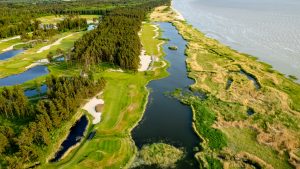The first tee is a bit intimidating. Looking down the first fairway the landing areas look very narrow.
The starter is a cheerful fellow, but you can feel him sizing you up; are you really good enough to play this course? He may have opinions about which tee you should use; generally hcp 9 or lower is required for anything further back than the yellow tees. Listen to his advice, be humble when choosing your tee and your round will be more enjoyable.
As it turns out, the landing area on the first fairway is quite a bit wider than it looks. This is the case on many of the holes, as they often have narrow passages between the sand dunes, but widen considerably further up where most balls land. The course designers have done an excellent job in tricking you to believe that the holes are considerably more difficult than they really are; not that they are easy by any means.
The first nine holes meander through the sand dunes next to the water, with foot-high rough and gorse on the sidelines. Plenty of pot bunkers for you to choose from. Or sometimes they seem to choose you, as your ball rolls into them as if drawn by a magnet. Once in a bunker, sometimes the only way out is to play backwards, since the front edge is not only high but also lined with tall, tough grass. The greens are big, hard, and undulated, making target golf a poor option. A better choice is the bump-and-run, provided you have managed the course properly and have laid up with an opening to the green in between the bunkers.
The second nine are a bit more inland, and are slightly different in nature. Here you find many blind tee shots, so if this is your first time on the course it is recommended that you spend the 45 pounds for a caddie. He will have the local knowledge and experience not only to tell you which club to use and where to aim, but also to know in which area beyond the hill your ball has disappeared and to help you find it. This is money well spent, you will avoid a lot of frustration.
All of this may make it sound like this course is a pain to play, but it is quite the opposite. You come away happy after having played one of the very best courses in the world (Royal County Down is currently rated the best course outside the United States). Provided you weren’t too concerned about your score.
| Royal County Down Golf Club (Championship Links) Information | |
|---|---|
| Number of holes | 18 |
| Greenfee, 1 (low) - 5 (high) | 5 |
| Course Availability | Open to Public |
| Course Type | Links |
| Course Designer | George L. Baillie / Tom Morris / Harry Colt / Donald Steel |
| Year Opened | 1889 |
| Website | www.royalcountydown.org |






